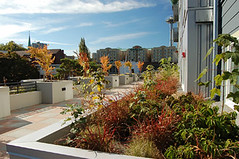Sustainable community building on display at Seattle's Denny Park apartments

Posted May 19, 2010 at 1:37PM
We’ve had an extended conversation at NRDC over the past several months on the subject of sustainable communities: which of our work best fits the phrase, and what is a sustainable community, anyway? (This all arose in the context of strategic planning.)
I would argue that most everything on this blog is an example, one way or another. I might also argue that a ‘sustainable community’ is best seen as an evolving aspiration with many manifestations, not something precise and fixed.  We should constantly be striving to improve our communities environmentally, socially, and economically, so that none of those values is sacrificed for another, and so that their future is not sacrificed for the present. I like to provide definition to the phrase with examples.
We should constantly be striving to improve our communities environmentally, socially, and economically, so that none of those values is sacrificed for another, and so that their future is not sacrificed for the present. I like to provide definition to the phrase with examples.
Seattle’s Denny Park Apartments provide a great illustration. Several years ago NRDC had the honor of helping Enterprise Community Partners (then the Enterprise Foundation) create its Green Communities program, designed to bring green building and sustainable site management to the provision of affordable housing across the country. Denny Park was the very first project assisted under the program.
Built by Seattle’s Low Income Housing Institute in the city’s South Lake Union neighborhood, Denny Park comprises 26 studio apartments, 11 one-bedroom units, and 13 two- and three-bedroom homes. Eight of the units provide transitional housing for homeless families with children. Over half the apartments serve households making 30 percent or less of area median income (AMI); the remainder serves households making up to 60 percent of AMI. The building also has a community room, an office, a common landscaped courtyard, and 4,400 square feet of ground-floor commercial space. The project occupies an urban infill site near the park of the same name and is served by public transportation.
All of that is praiseworthy in itself, but assistance from the Green Communities program also helped strengthen Denny Park with green building features.  Its energy design, for example, focuses on maximizing daylighting while minimizing solar heat gain during the summer months. The building is oriented along an east-west axis, with half the units facing north and half facing south. The common room and courtyard are located at the south side of the building, where they are warmed naturally by late-afternoon sun. A central, natural-gas hydronic system provides heat and hot water.
Its energy design, for example, focuses on maximizing daylighting while minimizing solar heat gain during the summer months. The building is oriented along an east-west axis, with half the units facing north and half facing south. The common room and courtyard are located at the south side of the building, where they are warmed naturally by late-afternoon sun. A central, natural-gas hydronic system provides heat and hot water.
Materials were selected largely for their cost-effectiveness and durability, and a jobsite recycling program led to the recycling of 91% of construction waste. Indoor air quality is protected by finishes with low chemical emissions and a no-smoking policy for the entire project. Low-flow plumbing fixtures reduce water use indoors.
We featured Denny Park at a press event back when Green Communities was first announced, but more recently I was reminded of the project by a new video highlighting seasonal maintenance on its green-roofing features, which include planters that capture and filter stormwater, minimizing runoff, while also providing both ornamental and edible urban gardens. These were designed by SvR Design Company, the project's landscape architects whose expertise includes advanced low-impact sustainability. SvR's staff volunteered their time to the spring maintenance and are featured in the video, explaining as they work.
The video, shot by Robert McFadden, captures a microcosm of sustainable community building in action:
Move your cursor over the images for credit information.